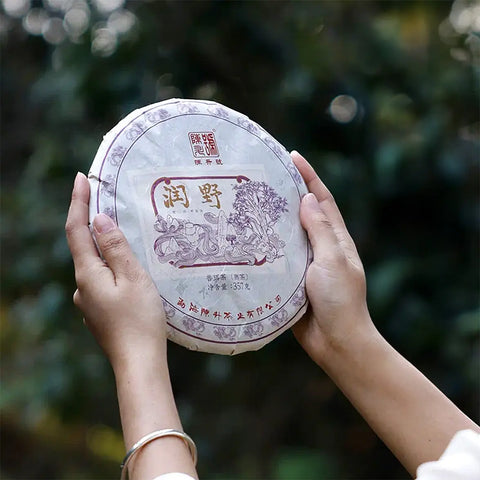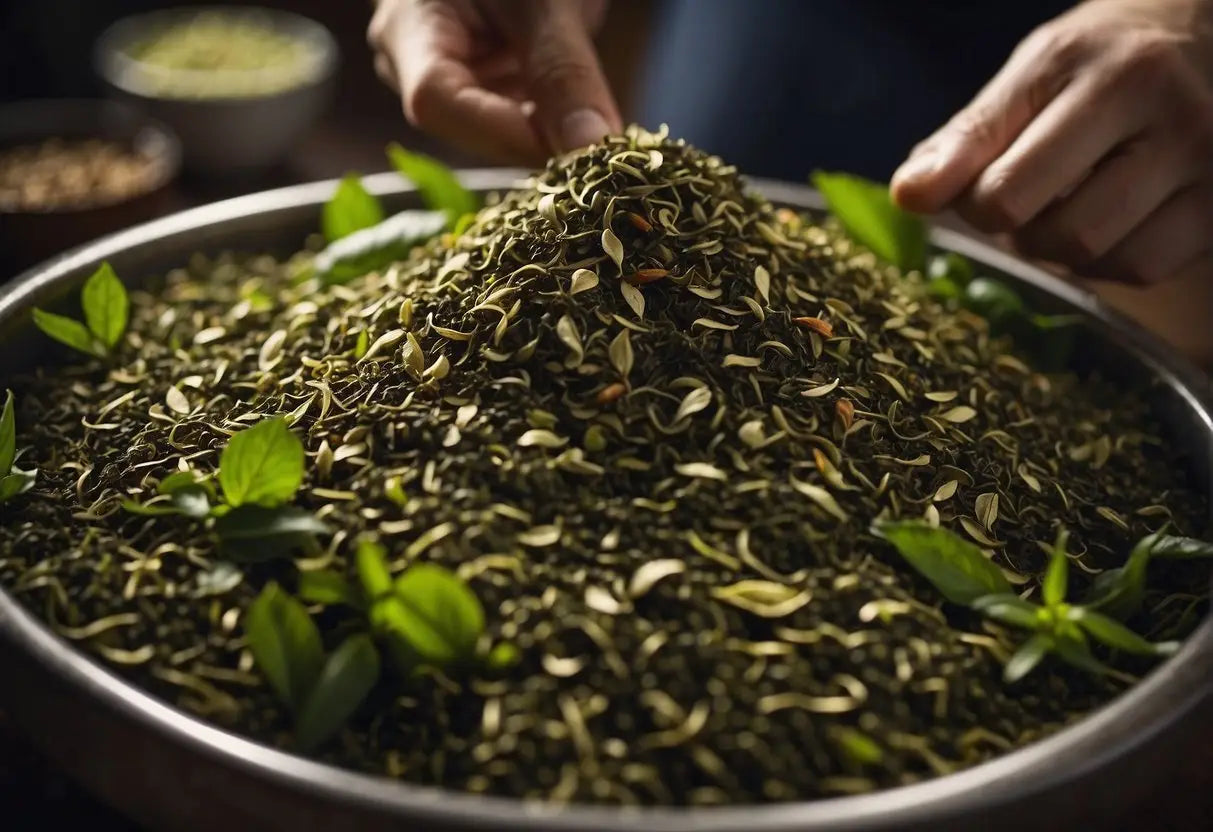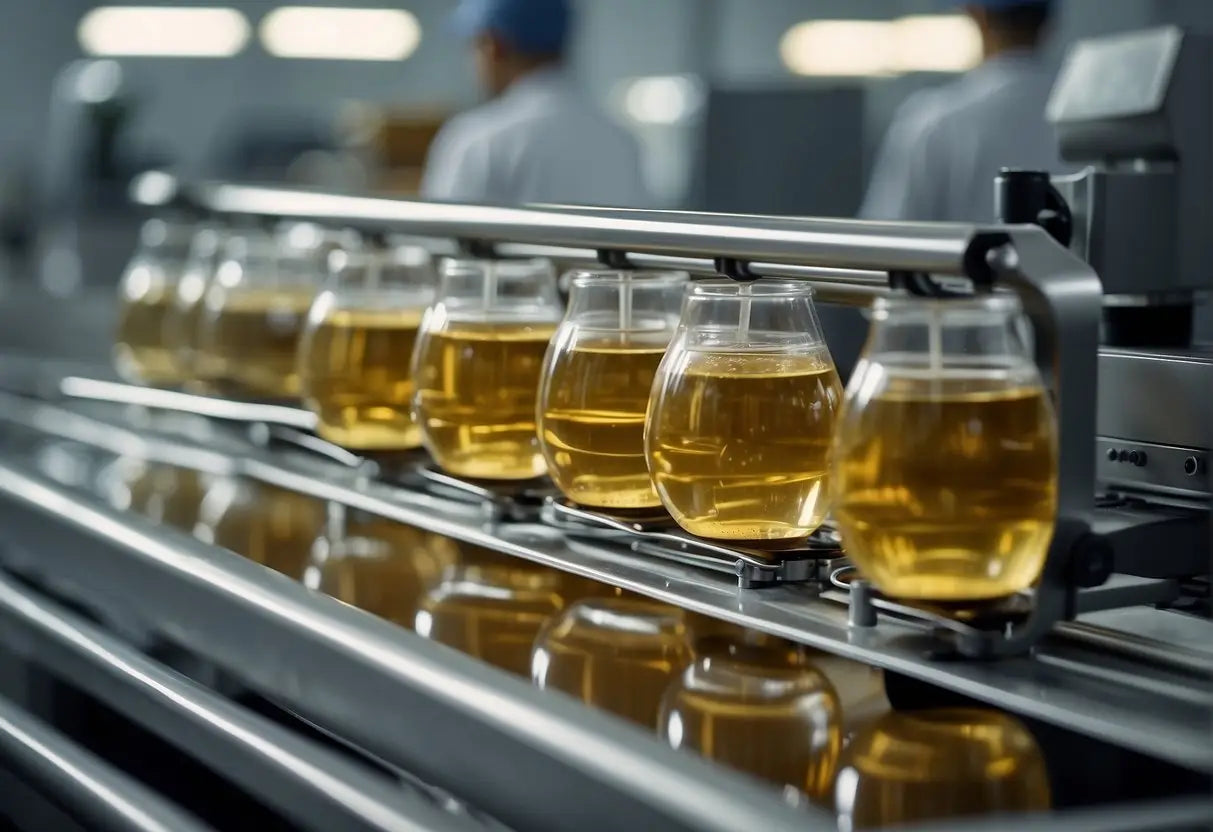What Are Tea Bags Made Of
Tea bags are crafted from various materials, each chosen for its properties to contain tea leaves and release flavor and aroma during steeping.
Paper Tea Bags
Traditionally, paper tea bags are made from a blend of wood and vegetable fibers, including abaca leaves and cellulose. The paper is lightweight and porous, allowing water to flow through and steep the tea leaves. The seams of these bags are often heat-sealed or crimped closed.
Materials Used in Paper Tea Bags:
Bestsellers
- Wood pulp
- Abaca plant fibers
- Cellulose
Silk and Nylon Tea Bags
Silk and nylon tea bags are synonymous with premium quality. Silk offers a luxurious feel, while nylon provides durability and a neutral taste. Both materials are heat-resistant, which makes them suitable for withstanding the high temperatures of brewing tea.
Characteristics:
- Silk: Luxurious, natural fabric, rarely used
- Nylon: Synthetic, strong, and fine-meshed
Biodegradable and Compostable Tea Bags
Biodegradable and compostable tea bags represent a sustainable alternative to traditional materials. They are made from plant-based resources such as corn starch, sugar cane, or wheat, breaking down completely in composting systems without leaving any toxic residue.
Compositions:
- Corn starch
- Sugar cane
- Wheat derivatives
Tea Bag Design
Tea bags come in various shapes and materials, specifically designed to enhance your brewing experience.
String and Tag Tea Bags
These typically feature a filter paper or foil pouch containing loose tea leaves, with a string attached for easy removal from your cup. The tag at the end serves as a grip and often carries the brand's logo.
Pyramid Tea Bags
Constructed from a fine mesh material, pyramid tea bags allow more room for the tea leaves to expand and unfurl, giving you a richer infusion. The three-dimensional shape promotes better water flow.
Circular and Rectangular Tea Bags
These shapes are sturdy and fit well in mugs of various sizes. Circular tea bags often lack a string and tag, while rectangular bags may include them. The choice between the two shapes is largely a matter of personal preference and brand identity.
Sealing Techniques

The sealing method used in tea bag production is critical to maintaining the integrity and quality of the tea. Different sealing techniques are employed to ensure that the tea bags remain intact during handling and use.
Heat-Sealed Tea Bags
Heat sealing is a common method where your tea bag's material is fused together through heat and pressure. Common materials used for heat-sealed bags include:
- Paper fiber
- Thermoplastic
- Filter paper coated with plastic
The process typically involves:
Lao Ban Zhang
- Positioning the tea bag material.
- Heating the edges.
- Pressing them together to create a seal.
Stitched Tea Bags
For stitched tea bags, the materials are sewn together using a string. This method often uses a more natural approach, including:
- Cotton
- Hemp
- Other natural fibers
Stitching provides a distinctive feature:
- It eliminates the need for glues and adhesives, which can appeal to those looking for a more 'natural' teabag option.
Ultrasonic Sealing
Ultrasonic sealing uses high-frequency sound waves to create a bond between the tea bag's materials.
Advantages of ultrasonic sealing include:
- Leaves no taste
- Creates a strong seal without heat
The procedure involves:
- Emitting ultrasonic vibrations
- Applying pressure to the tea bag materials
- Forming a secure seal without additional adhesives.
Environmental Impact

The choices you make regarding tea bags have a considerable effect on the environment, from production to disposal.
Sustainability Considerations
When you purchase tea bags, consider the materials used. Traditional tea bags are often made of paper with a small amount of plastic to seal them, which contributes to deforestation and can lead to plastic pollution. On the other hand, some tea bags are now made from biodegradable materials like corn starch or abaca hemp. Choosing these biodegradable options can reduce your environmental footprint.
| Material | Sustainability Factor |
|---|---|
| Paper | Contributes to deforestation, uses bleaches and dyes |
| Plastic | Creates microplastics, not biodegradable |
| Corn Starch | Biodegradable, generally derived from renewable sources |
| Abaca Hemp | Biodegradable, does not require pesticides or herbicides |
Choose materials that have a lower impact on natural resources and ecosystems.
Disposal and Recycling
When disposing of tea bags, different materials have distinct pathways. Most paper tea bags can be composted, but you must remove any staples or non-biodegradable parts. Tea bags that contain polypropylene, a type of plastic, are not typically recyclable and can take many years to degrade.
- How to Dispose:
- Compostable: Biodegradable tea bags, including loose tea leaves
- Non-recyclable: Traditional tea bags with plastic elements
- Landfill: As a last resort, when tea bags cannot be composted or recycled
Proper disposal techniques help minimize your contribution to landfill waste and the release of toxins into the environment.
Health and Safety Standards

When considering the materials used in the production of tea bags, your health and safety are paramount. Manufacturers are required to adhere to strict regulations to ensure that the tea bags you use are safe for consumption.
Food Grade Materials
All materials that come into direct contact with your tea are designated as food grade. This means they meet the necessary safety standards suitable for their intended use. Specifically:
-
Paper Tea Bags: Typically composed of a blend of wood and vegetable fibers.
- Heat-resistant to withstand brewing temperatures.
- Free from harmful chemicals.
-
Plastic Tea Bags: Sometimes made from food-safe synthetics like nylon or polyethylene terephthalate (PET).
- Must not release toxic substances when heated.
-
Silk Tea Bags: Made from natural silk with a high purity level.
- Rarely used due to cost but are still required to be food-safe.
Non-Toxic Adhesives
Tea bags may be sealed using adhesives, which are also strictly regulated. You can expect:
-
Adhesives: To be non-toxic and safe for contact with your beverage.
- Evaluated to ensure they don’t leach harmful substances when exposed to hot water.
Innovations in Tea Bag Manufacturing

The manufacturing of tea bags has seen significant advancements aimed at enhancing flavor retention and introducing unique designs that cater to consumer preferences.
Flavor and Aroma Preservation
Materials: Modern tea bags are often made from new materials such as soilon and nylon that are better at preserving the delicate flavors and aromas of tea. These materials are designed to be porous enough to let the tea infuse thoroughly while acting as a barrier against external odors.
Sealing Techniques: Manufacturers have also improved sealing techniques with the use of ultrasonic waves. This method ensures that the tea bags are sealed without affecting the taste of the tea leaves inside, unlike traditional heat sealing, which occasionally imparts a burnt flavor.
Specialty Tea Bag Designs
Shapes: To maximize infusion and aesthetic appeal, there are now a variety of tea bag shapes available, including pyramidal and circular designs. The pyramid shape, in particular, allows more space for tea leaves to expand and release their flavor.
Types of Specialty Bags:
- Drawstring Bags: Enables tighter sealing after steeping, enhancing the infusion process.
- Transparent Bags: Made from plant-based materials like PLA (polylactic acid), transparent bags let you appreciate the quality of the tea before brewing.
Detachability Features: Some tea bags now offer detachable tags and strings for a more sustainable steeping option, reducing material use and waste.
Frequently Asked Questions
Tea bags offer a convenient way to enjoy your favorite brew, but it’s important for you to be aware of the materials they're made from and the implications for health and the environment.
What materials are typically used for manufacturing tea bags?
Tea bags can be made from paper, silk, or food-grade plastics. The paper used is typically a blend of wood and vegetable fibers, while the plastics might include polypropylene to help seal the bags.
Are there any health risks associated with chemicals in common tea bags?
Some paper tea bags are treated with epichlorohydrin to improve strength when wet, which can break down into a potentially harmful compound. High temperatures can cause plastics in tea bags to leach molecules believed to disrupt hormonal activity in your body.
Which brands produce tea bags that are free from microplastics?
Brands like Pukka Herbs, Teapigs, and Clipper produce tea bags without microplastics, using organic materials like cotton or corn starch.
How can consumers identify and choose biodegradable tea bags?
You can look for certifications like TUV Austria's OK Compost or the Biodegradable Products Institute (BPI) label to ensure the tea bags are biodegradable.
What are the differences between paper and plastic tea bags in terms of environmental impact?
Paper tea bags break down more quickly in the environment compared to plastic ones. Plastic tea bags release microplastics upon degradation, which can be harmful to aquatic life.
Are major tea brands like Twinings, Tetley, and Lipton adopting plastic-free tea bag options?
Twinings, Tetley, and Lipton are working towards sustainability, with Twinings offering a fully biodegradable plant-based tea bag and Tetley opting for a material that is 100% renewable and biodegradable. Lipton's pyramid teas are made with a plant-based material that is biodegradable.
← Older post Newer post →











